
About UsThe Numismatic Bibliomania Society is a non-profit organization promoting numismatic literature. For more information please see our web site at coinbooks.org SubscriptionsThose wishing to become new E-Sylum subscribers (or wishing to Unsubscribe) can go to the following web page link MembershipThere is a membership application available on the web site Membership Application To join, print the application and return it with your check to the address printed on the application. Membership is only $15 to addresses in the U.S., $20 for First Class mail, and $25 elsewhere. For those without web access, write to: David M. Sundman, Secretary/TreasurerNumismatic Bibliomania
Society AsylumFor Asylum mailing address changes and other membership questions, contact David at this email address: dsundman@LittletonCoin.com SubmissionsTo submit items for publication in The E-Sylum, just Reply to this message, or write to the Editor at this address: whomren@coinlibrary.com
BUY THE BOOK BEFORE THE COINYou won't regret it! |
- WAYNE'S WORDS: THE E-SYLUM JULY 27, 2008
- GEORGE FREDERICK KOLBE AUCTION SALE 106: SEPTEMBER 18, 2008
- GEORGE FREDERICK KOLBE AUCTION SALES 107 AND 108
- NEW BOOK: THE CANADIAN DICTIONARY OF NUMISMATICS
- HOLABIRD-KAGIN AMERICANA'S 2008 AMERICA'S GOLD RUSHES CATALOG
- GEORGE SELGIN'S "GOOD MONEY" AVAILABLE AT ANA CONVENTION
- DAVID LANGE ON AUGSBURGER'S "TREASURE IN THE CELLAR"
- JOURNAL OF EAST ASIAN NUMISMATICS NOW AN ONLINE MAGAZINE
- THE RESEARCH LIBRARY OF JAMES E. DICE AND M. LAMAR HICKS OFFERED
- THE NEW GUIDE BOOK OF U.S. TOKENS AND MEDALS: WHAT'S IN, WHAT OUT
- SOME CORRECTIONS TO LAST WEEK'S ISSUE
- RITTENHOUSE SOCIETY TO MEET AT BALTIMORE ANA
- CITIZENS COINAGE ADVISORY COMMITTEE INVITES PARTICIPATION IN BALTIMORE
- ON COIN-MAKING AND BUTTON-MAKING
- MORE ON THE USE OF ADJECTIVES IN COIN CATALOG DESCRIPTIONS
- INFORMATION REQUEST FROM MONTPELIER REGARDING JAMES MADISON'S MEDAL SET
- QUERY: BOOK MITES
- TAMS JOURNAL CITED BY HARVARD BUSINESS SCHOOL PUBLICATION
- IN PICTURES: HOW TO TELL IF MONEY IS COUNTERFEIT
- ZIMBABWE RUNS OUT OF PAPER TO PRINT MONEY
- CHARLOTTE MEDAL BOUGHT BY AUSTRALIA'S NATIONAL MARITIME MUSEUM
- LOW VALUE COINS BEING SMUGGLED OUT OF INDIA
- BEIJING OLYMPIC MEDALS COST $1.2 MILLION TO PRODUCE
- WHO WAS THAT BEARDED MAN?
- FEATURED WEB PAGE: AMERICAN GOLD BY Q. DAVID BOWERS
WAYNE'S WORDS: THE E-SYLUM JULY 27, 2008
 New subscribers this week include Steve
Fahrlender, courtesy of Ken Berger. Welcome aboard! We now have 1,162
subscribers. This is a big week for the Numismatic Bibliomania Society -
our annual symposium and general meeting will take place at the ANA
Convention in Baltimore, MD. I expect to be at the convention all day
Thursday, and my wife and I will attend the banquet Saturday night. I hope
to see many of you there.
New subscribers this week include Steve
Fahrlender, courtesy of Ken Berger. Welcome aboard! We now have 1,162
subscribers. This is a big week for the Numismatic Bibliomania Society -
our annual symposium and general meeting will take place at the ANA
Convention in Baltimore, MD. I expect to be at the convention all day
Thursday, and my wife and I will attend the banquet Saturday night. I hope
to see many of you there. We open with information on the upcoming Kolbe numismatic literature sales, a new book on Canadian numismatics, and a new price list of U.S. gold rush items.
In the news, the cutoff of banknote paper to inflation-ridden Zimbabwe is fueling a cash shortage (and the troops are growing restless). Also, the unique Charlotte medal is purchased by Australia's National Maritime Museum.
To learn about the arrest of a Walter Breen imposter, read on. Have a great week, everyone.
Wayne Homren
Numismatic Bibliomania Society
GEORGE FREDERICK KOLBE AUCTION SALE 106: SEPTEMBER 18, 2008
Runs of W. Elliot Woodward, Ed. Frossard, Barney Bluestone, and M. H. Bolender auction sale catalogues; scarce Lyman Low sales; Ford's complete set of Kolbe's The Numismatic Bookseller; Ford's annotated Alexander Vattemare Presentation Album sales; a fine copy of Vattemare's 1861 "first comprehensive catalogue of American Numismatics" from the numismatic department of the French National Library; Ford's set of annotated NASCA sale catalogues;
An exceptional, complete set of Ruddy's Review; a complete original subscriber's set of hardbound Remy Bourne sales; Elder's 1908 James B. Wilson Sale with 28 photographic plates; a copy of Henry Chapman's 1916 Bement sale catalogue with six unique photographic trial plates; standard multi-volume works on ancient coins; Meili's monumental 1903 work on Brazilian paper money; a set of Calciati's Pegasi; Storer's 1931 Medicina in Nummis, etc.
Copies of the printed catalogue may be obtained by sending $15.00 to George Frederick Kolbe, P. O. Box 3100, Crestline, CA 92325. Telephone: (909) 338-6527; Fax: (909) 338-6980; Email: GFK@numislit.com . The catalogue will also be accessible free of charge, several weeks before the sale, at the firm's web site: www.numislit.com .
GEORGE FREDERICK KOLBE AUCTION SALES 107 AND 108
Kolbe Books is also pleased to announce the sale of the highlights of two important numismatic libraries on January 10, 2009 in New York City at the Waldorf Astoria Hotel, during the New York International Numismatic Convention. The first is the superb library of antiquarian numismatic books dating from the early 1500s, along with classic works on Italian numismatics from the library of Dr. Ferdinando Bassoli of Turin, Italy.Following it will be a select but remarkable collection of classic works on United States large cents and auction sale catalogues with photographic plates, featuring some three dozen plated Chapman Brother catalogues and nearly all the great large cent literature rarities, including an 1881 Andrews and leather-bound editions of Newcomb on 1801-1803 cents and Clapp on 1799 cents. Copies of either printed catalogue may be obtained by sending $25.00 to George Frederick Kolbe or $35.00 for the pair.
NEW BOOK: THE CANADIAN DICTIONARY OF NUMISMATICS
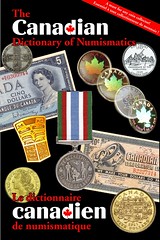 The first edition of “The Canadian Dictionary
of Numismatics/Le dictionnaire canadien de numismatique” by Serge
Pelletier, is now available from the publisher.
The first edition of “The Canadian Dictionary
of Numismatics/Le dictionnaire canadien de numismatique” by Serge
Pelletier, is now available from the publisher.“Dictionaries tend to be dull recitations of definitions peppered with a few facts and examples. ‘Enjoyment’ is not a word that often comes to mind when thinking about reference books. Until now” said Doug Andrews, columnist at World Coin News after reviewing the latest book by world-renowned coin writer Serge Pelletier. “The result of more than a decade of research, this work is as meticulously documented as it is entertaining to read. Entries are crisp, informative and provide revealing insights into the collection and study of coins, tokens, and paper money” he concluded.
When asked why he prepared this work when there are already several numismatic dictionaries, glossaries and lexicons in English and French, Pelletier explained: “It is true that several works on the subject exist but I have found them wanting. First most of these numismatic dictionaries come from countries other than Canada, and despite their commendable qualities, they generally do not reflect the interests of collectors of Canadian coins and paper money. Second, the entries rarely, or briefly, include Canadian numismatics and when they do, they are often inaccurate. Finally, most cater only to the learned. This dictionary fills the gaps left by these works and is, first and foremost, destined for beginners and scholars alike – so the beginner may look up PCGS and the advanced collector specialized in paper money may look up the Vexator Canadiensis token.”
“Although the focus is on Canadian coin collecting, there is extensive coverage of American, British, and French coinage. The book is authoritative and thought provoking, and is sure to become an eagerly sought after reference for both beginning and advanced collectors, or those with everyday questions about Canadian currency and its fascinating history” said Andrews.
The book is completely bilingual (with French and English entries cross-referenced) and ably fills a void that has always existed in Canadian numismatic publishing. This all-new volume is 6” x 9” in size with 320 pages, 40 of which are colour plates. It is available in two formats: hardbound @ $90 post-paid (ISBN 978-0-9808944-1-7) with an initial run of 25 copies; perfect bound @ $45 post-paid (ISBN 978-0-9808944-0-0) with an initial run of 500 copies. An electronic version may also be added for $15 (sold only with a printed copy). The CD-ROM contains a locked PDF copy of the dictionary. Orders may be placed with Eligi Consultants Inc., which can reached at: Box 11447, Station H, Nepean, ON K2H 7V1 CANADA, fax: +1-613-599-7630, Email: info@eligi.ca. Canadian resident must add the applicable taxes.
Pelletier is the award-winning author of several books including A Compendium of Canadian Municipal Trade Tokens and the six-volume Standard Catalogue of Canadian Municipal Trade Tokens. He has served as President of the Association des numismates francophones du Canada and as Vice President of the Canadian Numismatic Association. He was a contributor to the Canadian Numismatic Correspondence Course, Parts One and Two, and has been published throughout the world in most of the major numismatic periodicals.
HOLABIRD-KAGIN AMERICANA'S 2008 AMERICA'S GOLD RUSHES CATALOG
 We are pleased to announce that the printed
version of the brand new 2008 Holabird-Kagin Americana America's Gold
Rushes catalog is now available for ordering. This exciting 560 page, full
color book is far more than just a catalog, it is also a valuable
reference piece covering the most important Gold Rush-related items ever!
This is a must have for collectors, historians, researchers, librarians,
and everyone with an interest in knowing more about the people and places
that made the Gold Rush era such an exciting time in American history.
We are pleased to announce that the printed
version of the brand new 2008 Holabird-Kagin Americana America's Gold
Rushes catalog is now available for ordering. This exciting 560 page, full
color book is far more than just a catalog, it is also a valuable
reference piece covering the most important Gold Rush-related items ever!
This is a must have for collectors, historians, researchers, librarians,
and everyone with an interest in knowing more about the people and places
that made the Gold Rush era such an exciting time in American history.
Printed copies are $50 shipped to US addresses. To order your copy, please call Holabird-Kagin Americana at (775) 852-8822. You may also send your address information to info@holabirdamericana.com or
Holabird-Kagin Americana
3555 Airway Drive, Suite 308
Reno, NV 89511
Interested in a Special Collector's Edition?
We are considering producing a special, limited Collector's Edition of America's Gold Rushes. At $300 each, this special edition isn't for everyone, but for serious collectors and researchers who want a long-lasting reference piece, the cost will be easily justified. This will be a hard-cover, sewn binding, numbered and autographed edition that will be a great addition to any rare book, Americana, or numismatic library. If you would like a chance to obtain the Collector's Edition, please contact us immediately.
The largest single class of items is assay receipts, but many other interesting types of items are included, such as gold-rush related letters, photos, books and pamphlets. Pioneer gold coins, ingots and related medals are featured as well. Some of my favorites are the Harvey Harris assay ingots, and the 1856 Vigilance Committee medals. Perhaps the most unusual item is #2, a Western Cattle Horn Chair, circa 1895.
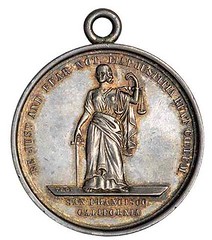
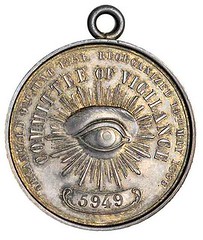
Fred has done a good deal of research, and it shows in the pages of this catalog. One key reference source on gold rush banking and bankers was Ira Cross' Financing an Empire: History of Banking in California, as well as contemporary newspapers. I wouldn't be surprised to see this catalog become one of those rare Fixed Price Lists which become a standard reference in their field.

GEORGE SELGIN'S "GOOD MONEY" AVAILABLE AT ANA CONVENTION
 Regarding George Selgin's new book Good
Money: Birmingham Button Makers, the Royal Mint, and the Beginnings of
Modern Coinage, 1775-1821, Scott Loos writes:
Regarding George Selgin's new book Good
Money: Birmingham Button Makers, the Royal Mint, and the Beginnings of
Modern Coinage, 1775-1821, Scott Loos writes:
DAVID LANGE ON AUGSBURGER'S "TREASURE IN THE CELLAR"
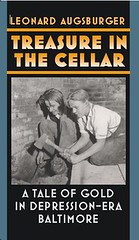 Dave Lange of Bradenton, FL writes:
Dave Lange of Bradenton, FL writes:
JOURNAL OF EAST ASIAN NUMISMATICS NOW AN ONLINE MAGAZINE
Bruce W. Smith writes:

THE RESEARCH LIBRARY OF JAMES E. DICE AND M. LAMAR HICKS OFFERED
Dave Perkins writes:THE BOOK BAZARRE
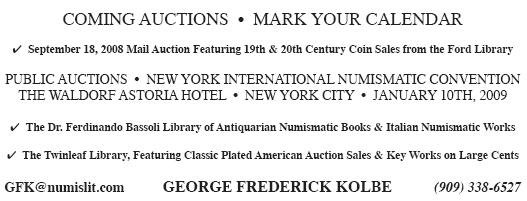
THE NEW GUIDE BOOK OF U.S. TOKENS AND MEDALS: WHAT'S IN, WHAT OUT
Bob Knepper writes:The Mardi Gras doubloons are issued by the marching societies - so now I'm not sure whether they are included or not. Mardi Gras doubloons/medals already fill a medium size book. A few of the early, 1884-1895, doubloons from the Krewe of Rex happen to include "my" wildmen - though not very good ones. Thus I'm curious if they are in the new book.
Richard Jewell writes:
It would be a major error if the book did not include the Mudie Series of National Medals. But there we aren't talking about a guide book, are we? Perhaps another Whitman book is in the works to cover this National series of United States Medals! Olympic Participation Medals were not mentioned either, but they may have been washed over in the "Exclusion Preface" with "not enough space for Olympic events"? All are possible suggestions for future reference works.
SOME CORRECTIONS TO LAST WEEK'S ISSUE
Ron Thompson writes:RITTENHOUSE SOCIETY TO MEET AT BALTIMORE ANA
Dave Bowers writes to say that the Rittenhouse Society will have its annual meeting at the ANA Convention in Baltimore. If you are a member and have not received notice, this means Dave does not have your current e-mail address. To remedy this, please contact Dave at: qdbarchive@metrocast.netCITIZENS COINAGE ADVISORY COMMITTEE INVITES PARTICIPATION IN BALTIMORE
Mitch Sanders, Chair, CCAC writesWe always look forward to interacting with the numismatic community at the A.N.A. convention, and we hope that anyone interested will attend our meeting and share their thoughts with us.
The meeting is scheduled for 9 AM on Friday August 1, in Room 316 of the Baltimore Convention Center. I hope to see you there!
ON COIN-MAKING AND BUTTON-MAKING
Carl Honore of Puyallup, WA writes:Ron Abler writes:
Mr. Johnson is right. It is striking (pun intended) how similar these mementos are in their manufacture: die-struck obverses with a dazzling array of reverses and/or shapes that betray their intended purpose. An Expo visitor with no numismatic bias might actually conclude that the medals could be defined simply as two-faced die-struck souvenirs with no discernible utilitarian purpose!
MORE ON THE USE OF ADJECTIVES IN COIN CATALOG DESCRIPTIONS
- liquid fire full cameo
- glossy sharp rims
- mellowed natural tan color
- exceptionally mirrored surface
These are from a series of ads in Coin World in 1995. The seller had undoubtedly studied descriptions of expensive coins. What I learned is there is a direct ratio between the offering price of the coin and the amount of hype and hyperbole in its describing. Greater cost, greater hype. Be on lookout for any word within quotation marks:
- "real" coin
- "glows" with silvery white radiance.
Out and out hyperbole:
- aura of respectability
- desirable in any grade
- greatest coin of all time
- magnificent specimen
- never have an equal
- for the ultimate collection
These are all exact wording from the ads of The Mint of Kansas City. Here is my candidate for the worst coin description in one of their ads -- for a gem 1879 Three Cent Piece (from Coin World, July 10, 1995, page 11):
- very, very pretty!
INFORMATION REQUEST FROM MONTPELIER REGARDING JAMES MADISON'S MEDAL SET
Lance has found a Google Books citation to The Numismatist that reads "The exhibits were as follows: By Mr. Blake: A case of seven bronze medals presented to President James Madison by George W. Erving..." The Google Books citation reads: 1894, p. 143. This is incorrect--it reflects the date of the first volume of The Numismatist that Google scanned, not the actual date of the issues of The Numismatist in which the content occurred.
"Mr. Blake," of course, is George H. Blake, the renowned paper money authority, who was an active collector from the late 1890s until his death in early 1956. The snippet from Google Books is probably a report in The Numismatist about a monthly meeting of the New York Numismatic Club. Can any readers of The E-Sylum help to pinpoint the date of the report in The Numismatist; how the Madison medal set left the Madison family; from what source Blake may have acquired the set; and what my have happened to the set post-Blake? (George H. Blake is not listed as a consignor to any American numismatic auction sale by Martin Gengerke).
No monetary award involved, but I suspect that someone providing great information could wangle a behind-the-scenes tour at Montpelier from Lance!
QUERY: BOOK MITES
A few times while reading, I thought I saw movement on the page. My eyes not being as sharp as they used to be, I couldn't really verify it. Until last night - I stopped my reading and pulled the book close to my face. I saw the tiniest insect I've ever seen (way smaller than an aphid), nearly the same color as the yellowed page, maybe a touch whiter - ecru, I guess. Hard to imagine that any living thing, other than a microbe, could be so small. It was running across the page I'd just turned, evidently not liking the burst of light.
Now I'm not particularly squeamish about bugs, and I was enjoying the story (Thomas Mann's Little Hanno) and decided to worry about it later. I fell asleep, and this morning, in my rush to work, left the book on the bed. For about the tenth time.
I've just been web surfing on "book mites" and "book lice" and have read that the remedy is freezing, or putting the book in a hot dry place for a while. My question is, should I be majorly bummed that I've been sleeping with these critters? Actually, I feel sorry for them, in their tinyness, having to sleep with me, but, still...I'm not entirely happy with the term "lice." Any expertise among the readership?
TAMS JOURNAL CITED BY HARVARD BUSINESS SCHOOL PUBLICATION
The HBS working Knowledge e-mail newsletter "... summarizes new working papers, case studies, and publications produced by Harvard Business School faculty." In this case, the newsletter highlighted an article in the April 2008 journal of the Token and Medal Society. Author Louis Wells is a faculty member. -Editor
Authors: Louis T. Wells
Publication: TAMS Journal 48 (April 2008): 36-42.
Abstract
Few numismatic fields are as unexplored as the tokens of what was once the Belgian Congo. Although the head (and "extra-wife") tokens have been thoroughly cataloged, I have found only one very early and incomplete attempt, by Mahieu in the 1920s, to report other tokens from this vast territory. Most of the tokens in this article that have not been previously listed were obtained in markets in Kinshasa between 2000 and 2005. Given the poor communications and regional violence, tokens from the eastern and even central part of the Congo were unlikely to appear in this western-located city. Probably many more tokens were issued in association with the Congo's important mines and plantations. This "Part I" article should serve as a start for the development of a "Part II" with a more complete list and history of issuing companies. Until then, the tokens of the former Belgian Congo and its independent successor states remain largely in darkness.
IN PICTURES: HOW TO TELL IF MONEY IS COUNTERFEIT
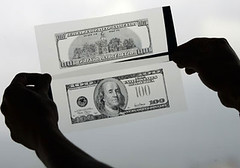

To read the complete article, see: In Pictures: How To Tell If Money Is Counterfeit (http://www.forbes.com/business/2008/07/23/
money-counterfeit-currency-biz-cz_ph_0723counterfeit_slide.html)
ZIMBABWE RUNS OUT OF PAPER TO PRINT MONEY
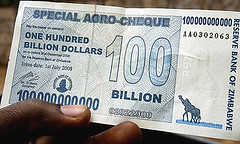 The Zimbabwean government was today struggling
to find enough cash to pay its workers, and more importantly the military,
after it was forced to severely cut back on printing money because
sanctions severed its supply of banknote paper from Europe.
The Zimbabwean government was today struggling
to find enough cash to pay its workers, and more importantly the military,
after it was forced to severely cut back on printing money because
sanctions severed its supply of banknote paper from Europe.
Officials involved in the printing of money said the regime was fearful that the presses could be shut down altogether if further political pressure causes the withdrawal of software licences used to design and print the notes.
On Monday, the central bank issued a $100bn note, the highest denomination to date but worth only about 7p, printed on what remains of stocks of the German-supplied paper.
The source said the firm had been told that new supplies of currency paper were coming from Malaysia but it was unable to meet the current demand for cash created by hyperinflation that economists estimated was running at about 40m%.
The speed of the devaluation can also been seen in the watermarks. Hold a $750,000 note up to the light and the watermark shows the paper was intended to be used for a $1,000 bill. The $25bn note has a $500 watermark.
To read the complete article, see: Soldiers await pay as Zimbabwe runs out of paper to print money (http://www.guardian.co.uk/world/2008/jul/23/zimbabwe)
CHARLOTTE MEDAL BOUGHT BY AUSTRALIA'S NATIONAL MARITIME MUSEUM
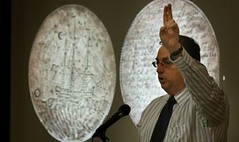 The crowd of medal collectors breathed a
collective sigh and craned in their seats as Australia's first piece of
colonial art sold for $750,000 at auction to a beaming mystery buyer
seated in the third row.
The crowd of medal collectors breathed a
collective sigh and craned in their seats as Australia's first piece of
colonial art sold for $750,000 at auction to a beaming mystery buyer
seated in the third row.Minutes later, it was revealed that the National Maritime Museum had bought the Charlotte Medal — a silver disc engraved by the convict and expert forger Thomas Barrett when the First Fleet arrived at Botany Bay. Even the most hardened medal collectors paused in their bidding to clap.
Very little material survives from the ships of the First Fleet, so the Sydney museum sent its assistant director of collection and exhibitions, Michael Crayford, to Melbourne to secure a seminal piece of Australian history.
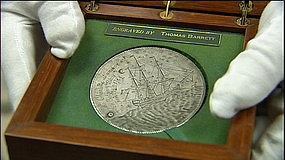 "It is also one of the best artworks for that
period (so) we're absolutely thrilled to have it and it will be on display
to the public within weeks," Mr Crayford said.
"It is also one of the best artworks for that
period (so) we're absolutely thrilled to have it and it will be on display
to the public within weeks," Mr Crayford said.The silver disc was sold by John Chapman, a retired dentist, who bought it at auction in 1981 for $15,000.
The rest of his extensive collection of Australian medals, coins and banknotes, valued at $1.6 million before auction, also went under the hammer at the Noble Numismatics auction yesterday.
"I'm very pleased because what I wanted was for the medal to be displayed to the public," Dr Chapman said. "You realise that in the end you can't own these things, you're just the custodian."
To read the complete article, see: Coin forger's medal fetches a pretty penny (http://www.theage.com.au/national/coin-forgers-medal
-fetches-a-pretty-penny-20080722-3jcz.html)
To read a related article, see: First Fleet medal sells for $750,000 (http://www.abc.net.au/news/stories/2008/07/22/2311247.htm)
When informed of the hammer price, Alan Weinberg commented:
Later Alan added:
I was aghast when I first heard and read the estimate. $250,000 maybe. To my knowledge, no silver medal of any country has exceeded at auction $230K (plus buyer's fees). That record was set by the genuine oval George Washington Indian Peace Medal in the Stack's Ford sales.
I simply cannot believe there was an underbidder driving up the Charlotte medal to its estimate and proclaimed value of $750,000 Aus. That was a reserve and the National Maritime Museum, using taxpayer funds, just paid it.
LOW VALUE COINS BEING SMUGGLED OUT OF INDIA
This is creating a coin shortage in northeastern India. Merchants there are printing cardboard tokens same size as the coins to overcome the shortage. Sound familiar? This emergency solution has been used universally for hundreds of years.
It will continue in countries throughout the world until governments realize they must eliminate low denomination coins and turn to rounding off to a denomination in which the metal in that denomination coin is not vulnerable to melting.
American Congressmen and U.S. Treasury officials should note this trend as well. This is a lesson in economics they have not learned yet as our cent and five-cent piece face this same vulnerability.
To read the article in an Indian newspaper: Ringing In The Change (http://www.tehelka.com/story_main40.asp?
filename=Bu020808ringinginthe.asp)
BEIJING OLYMPIC MEDALS COST $1.2 MILLION TO PRODUCE
Ironically, given the location of next month's Games, much of the impetus for the surge in commodity prices in recent years has come from China's insatiable appetite for raw materials to fuel its economic expansion.
To read the complete article, see: Why Beijing Olympic medals are worth their weight in gold (http://www.telegraph.co.uk/money/main.jhtml?
xml=/money/2008/07/27/cngold127.xml)
WHO WAS THAT BEARDED MAN?
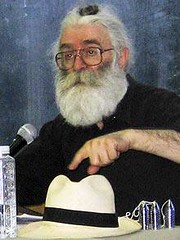
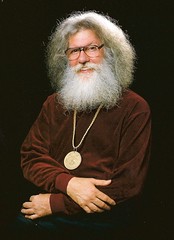
FEATURED WEB PAGE: AMERICAN GOLD BY Q. DAVID BOWERS
This week's featured web page is an American Heritage article by Q. David Bowers on AMERICAN GOLD.http://www.americanheritage.com/articles/magazine
/ah/1984/1/1984_1_42.shtml
